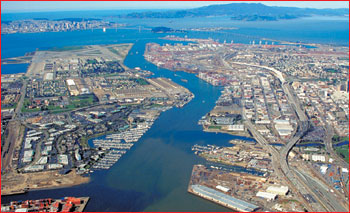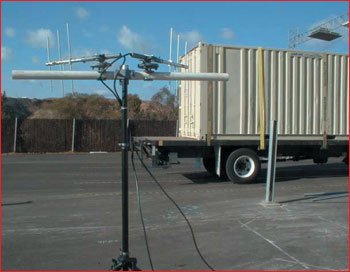Key Freight Transportation Challenges
National Security
For the most part, the freight transportation system has been designed with productivity in mind. Up until recently, concerns about security generally focused on controlling theft and reducing contraband. Less attention was given to the vulnerability of the freight network to terrorism. The events of September 11, 2001 changed that. The focus is now on preventing attacks and reducing system vulnerability while keeping commerce moving.
Security involves protecting transportation assets—facilities, vehicles, and supporting infrastructure (communications structures and power stations)—from a host of potential threats. Security also involves protecting transportation assets from being used as instruments in carrying out terrorist attacks on civilian, industrial, or military targets. The use of commercial aircraft in the attacks of September 11th and the use of a rental truck to bomb the federal building in Oklahoma City are two painful examples.

The Port of Oakland is one of the top 10
container ports in the United States.
Source: U.S. Army Corps of Engineers
Because of its accessibility, extent, and diversity, the U.S. transportation system presents many opportunities for terrorists both from within and outside the United States. In particular, the freight sector's increasing dependence on the use of containers, intermodal transport, and global supply chains poses multiple security risks. In 2001, an estimated 19 million containers entered the United States through water ports and land ports. Few containers are tracked as they are transported to their final destinations, and the routes used are often in close proximity to some of America's most populated cities.
Given these risks, several
freight security priorities have emerged. The top priority is general
cargo in international commerce. Because of the potential for a "bomb
in a box," the priority given to container and containership security
is understandable. Domestically, the major focus is on hazardous materials
transport, which relates primarily to highway and railroad operations.
Other top priorities include air cargo services, domestic general commodity
movements, and exports. Prior to September 11, these movements received
only sporadic attention.

To ensure cargo security, tracking technologies like this one are being
field tested by the International Mobility and Trade Corridor partnership in the Pacific Northwest.
Source: Transcor
Information about ownership and location of containers as they move from origin to destination is crucial in reducing the vulnerability of the freight transportation network and related infrastructure. A system of tracking containers and identifying custodians of the cargo is now being developed. Smart cards that contain biometric identifiers and cargo information connected to an electronic manifest can be used to establish a chain of custody. Other technologies that offer the potential to enhance security and supply chain efficiency include supply chain software that can accommodate security applications, electronic cargo seals, and wide-area communications combined with global positioning systems or other global location technologies. These technologies also can be useful in tracking hazardous materials shipments and freight being moved across our international borders.
The freight transportation network also may be affected by responses to terrorism and other incidents, such as hazardous materials transport incidents. Shutting down the U.S. aviation system for a few days after September 11 is an example of a response to terrorism. Another example is the closing of the Howard Street tunnel in Baltimore for several days after a train carrying hazardous materials derailed. Other responses, or countermeasures, may have longer-term repercussions. Continuing security delays in processing air cargo is just one example.
Intertwined with the increased focus on freight security is the need to keep commerce moving and further boost productivity and reliability. In recent years, freight transportation and logistics systems have become tightly coupled, resulting in efficient global supply chains. In this environment, predictability and reliability are critical to shippers and carriers. Enhanced freight security has the potential to affect reliability and timeliness of deliveries by disrupting well-tuned supply chain operations. Enhanced freight security measures may also provide opportunities for increasing efficiency and productivity.
Clearly, the extensive and readily accessible U.S. freight transportation network is vulnerable to terrorism. Many efforts are needed to enhance the security of the system. Some security needs are urgent while others are longer-term goals. Thus, the challenge for transportation decisionmakers is to balance security needs with freight productivity. Neither goal is mutually exclusive. If designed and implemented well, security measures have the potential to improve efficiency and customer service and reduce losses from theft.
previous | next